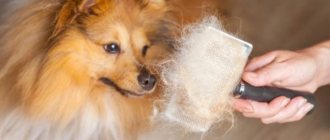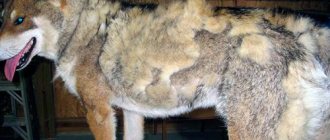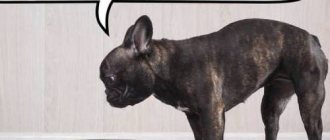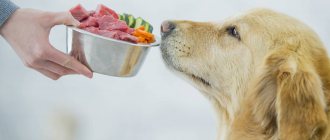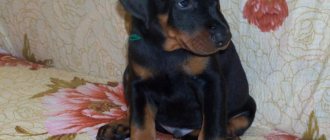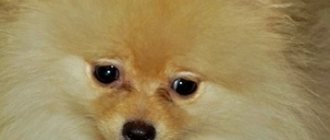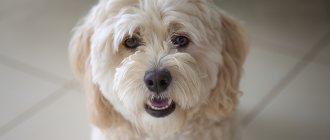Animal fur does not grow forever, and sooner or later it falls out. This process is repeated again and again as it grows. Therefore, for many dogs, shedding is simply inevitable. Most often, the animal is covered with a thick layer of fur before the onset of cold weather, but before summer, on the contrary, the fur thins out, thereby freeing up space for the penetration of sunlight. Despite the fact that the pet is kept at home, natural processes cannot be stopped. Many owners complain about excessive shedding in their pets. When should you sound the alarm?
Shedding in dogs
What is shedding and why does a dog need it?
Thanks to the renewal of the hair coat, the dog prepares for weather changes, acquiring a thinned coat with a predominance of guard hairs before summer, and a thick and dense undercoat before winter.
At the same time, the length of the vegetation does not at all affect its tendency to fall out. It is so laid down by nature that damaged and thinned old wool, having fulfilled its insulating function, gives way to new one.
Like any cyclical physiological process, molting cannot be canceled or delayed. To understand the inevitability of shedding, you need to understand why the dog was given fur in the first place. In addition to exceptional external advantages and protection from adverse climatic conditions, it is required to regulate body temperature.
The owner can help the pet by promptly removing dead hair and tangles (in the case of some breeds, the concept “promptly” should be read as “daily and year-round”).
Special grooming procedures
Properly selected vitamin and mineral complexes and nutritional supplements can reduce the duration and intensity of the seasonal process. If they do not have a noticeable effect, you should consult a veterinarian. He will tell you what to do when your dog sheds heavily. You can also use grooming services.
Express molt
Professionally performed combing is called express shedding. It is carried out by a master in a hairdressing salon for animals, that is, in a grooming salon.
Express shedding includes brushing with a furminator brush, bathing with shampoo and conditioner, and drying with a special hairdryer. The procedure makes it possible to remove up to 90% of dead hair, and the effect lasts up to 3 months.
Trimming
Removing dead hair by plucking is called trimming. This is a health and hygiene procedure carried out in the salon. Trimming is recommended for wire-haired breeds (listed above), which find it difficult to shed dead particles on their own. A salon procedure is performed on average once a quarter, which allows you to maintain a neat appearance for your pet.
How many times a year does a dog normally shed heavily and at what time?
The puppy exchanges baby fluff for the first fur at the age of about 2 months, and this in turn - at 6 months - for the adult coat.
If we are talking about an adult dog and a seasonal change in hair, it is supposed to shed twice a year: in spring and autumn for about 2-3 weeks. After all, nature has determined that the dog will sleep in the snow in cold weather thanks to its powerful undercoat, and in hot weather it will not mind the bright sun, since its long and strong awn will protect it from heat stroke.
And that is why, sometimes, the body of a dog living in a greenhouse apartment becomes slightly perplexed. An animal that goes outside for half an hour a day does not feel climate changes and begins to shed little by little all year round.
Some dog breeders call this a funny word, “shedding.”
When and for how long does the coat change?
Autumn shedding is long-lasting, since its task is to build up a thick undercoat. It begins before frost (it is difficult to name exact dates; it depends on the climate zone and current weather conditions) and can last up to one and a half months. After the autumn molt, the pet seems more voluminous and fluffy.
The spring coat change, on the contrary, is characterized by a rapid shedding of winter fluff and therefore lasts significantly less: 1-2 weeks. It begins as soon as it stops being frosty at night (again, here you need to look not at the calendar, but at the thermometer).
Features of shedding by breed
In long-haired
Long-haired dogs are prone to matting. The rich fur coat, consisting of long guard hairs and an impressive undercoat, requires daily brushing during shedding (the result can be a mountain of fluff equal in size to the dog itself).
Moreover, furry pets need to be cut and bathed at least once every 2 weeks. Neglecting this recommendation can lead to matted, unaesthetic tufts that cause irritation on the skin. And parasites, in turn, easily penetrate the wounds. By the way, we have an excellent article about choosing the best drops for fleas and parasites in dogs.
In shorthaired
Smooth-haired dogs shed just as actively as their long-haired relatives, but this process is not as noticeable. But the results of shedding are clearly visible indoors, where short bristles are scattered in large quantities in the corners and baseboards.
The group of short-haired dogs includes many Molossians, Dalmatians, Dobermans, Dachshunds and other owners of needle-haired dogs. Representatives of these breeds are recommended to be brushed with a natural bristle brush, and also wiped twice a day with a terry towel or velor cloth that collects hairs.
In wire-haired
Wire-haired dogs, which include terriers and schnauzers, require specialized help from a groomer. Every six months they need to be taken for trimming (plucking by hand or using hairdressing tools). This requirement is due to the fact that the hard coat itself hardly falls out when shedding, but changing it untimely can cause problems for the dog.
The pet, feeling the need to shed old hair, begins to actively itch, damages the skin and opens the gates for infection.
Breeds that don't shed
Breeds that do not shed hair include, firstly, those that are not endowed with fur: the Xolo, the Chinese Crested Dog and the Peruvian Hairless Dog.
Many people believe that Basenjis and poodles do not shed, but in the first case, short light bristles are simply unnoticeable in the interior, and in the second, the hair gets tangled in curls and does not fall to the floor, although the hair follicles leave the skin and fall off like felt.
By analogy, we can recall the Komondor (a dog with dreadlocks, similar to a giant mop): his long curls, tangled in cords, continue to hang, although most of the hair in them has already fallen out.
Secondly, non-shedding breeds often include dogs whose hair is more reminiscent of long human hair: Afghan hounds and Yorkshire terriers. These sophisticated creatures have virtually no undercoat; their coat consists mainly of awns. Therefore, seasonal shedding is not relevant for them (after all, in the standard case, the dog grows undercoat in the fall and sheds it in the spring).
Important! Even the absence of a hint of vegetation does not guarantee that the owner will not be allergic to the pet. After all, in addition to the fluff itself, any animal has dandruff, which can become a powerful trigger.
Moreover, a person can begin to react to dust particles from dry food, and even to saliva protein or dog sweat, no matter how funny it may sound. And if the dog brings ticks in his symbolic fluff, the sensitive owner will be in doubly bad luck (asthmatics can react especially sharply).
How can the owner help the dog?
The owner can help the pet survive the molting painlessly, so that the animal does not scratch all its skin and does not remain in tangles.
If your pet doesn’t have suspicious rashes, scabs or visible damage, he doesn’t comb the same places and there are no visible bald spots, all you have to do is wait until the dog gets a new head of hair that will be the envy of everyone.
And, of course, the owner must understand whether the dog sheds more often and longer than expected.
In certain cases, constant, rather than seasonal, shedding can signal possible ill health. You need to evaluate whether a lot of hair is being shed, and if it is shedding in minimal amounts, then there is nothing to worry about.
But if in doubt, you can contact your veterinarian to rule out the following conditions:
- allergic skin rashes;
- presence of parasites;
- hormonal disbalance;
- stress;
- yeast dermatitis or bacterial disease;
- incorrect temperature conditions (when the room is more than 25 degrees, this is harmful not only for the beauty of the fur, but also for the heart).
In addition to the reasons listed, it is easy to assume pregnancy in females, during and after which increased hair loss is also likely.
Neutered shorthaired females, on the other hand, often shed year-round, but little by little.
Also, the answer may lie in insufficient or inappropriate nutrition: this condition is often the result of a food allergy, when the dog furiously scratches the skin and rips fur out of it.
For an owner who wants to understand the unnaturally long and intense shedding of a pet, the veterinarian may recommend an examination with a visual examination, trichoscopy, cytological examination, scraping and blood tests.
What tools and combs are needed
- Using combs with moving teeth and slicker brushes, the owner collects loose hairs before they fall to the floor. You need to comb in the direction of hair growth (towards the ends), but without pressing or scratching the skin. The fur should be dry and clean, and there should be no damage to the skin.
Important! Grooming tools in inept hands can scratch the animal, and no one will like the process of tearing out tufts. Therefore, the animal may be dissatisfied with the daily use of a slicker brush and a sharp comb.
- When using a furminator, the owner does not scratch the pet or tear out healthy fur. According to groomers, this tool reduces shedding by more than half. But there are also disadvantages: it is not cheap and cannot be used on damaged skin.
- Fine and short hair requires frequent combing with closely spaced teeth. This device removes dirt and parasites well.
- For short-haired dogs, soft brushes made of natural bristles and terry towels are recommended to remove loose hairs. You can also use massage mittens.
- In advanced cases, a tangle cutter may be useful: vertical, horizontal and drop-shaped.
- An alternative to a mat cutter is a clipper.
- The trimming knife is suitable for terriers and schnauzers. This device catches old bristles and painlessly removes them from the hard coat.
How to brush a dog: frequency of brushing
Dead hairs are removed with brushes and slickers. If there are damaged areas on the skin, it is better to do without brushes. The tool should be guided from roots to ends, pressing the hair towards the body without force.
Trying not to damage the skin, you need to brush with a leisurely movement and repeat this procedure 1-2 times a day.
Nutrition and vitamins
- B vitamins are a traditional recommendation. It cannot be said that they stimulate shedding, but they certainly have a beneficial effect on the condition of the renewed coat.
- It is often recommended to take brewer's yeast (preferably in the form of ready-made supplements).
- Fish oil also improves the condition of the hair.
It is important not to exceed the dosage, especially in the case of vitamins, since B-hypervitaminosis can lead to allergies. Only skin problems during the period of prolonged molting were not enough!
Proper and expensive food that ensures rapid coat change must contain a sufficient amount of protein, which gives strength and shine to the hair. During shedding, it is also recommended to give your pet raw offal. We also recommend reading about Holistic food for dogs.
Is bathing necessary?
- By purchasing special shampoos to renew the coat, you can notice improvements in the quality of the hair: it becomes more shiny, and the amount of dandruff decreases. But the main purpose of such a shampoo is to stimulate hair change: thanks to them, the old hair falls out even faster.
- Some groomers recommend using anti-shedding sprays that strengthen hair. These cosmetics act opposite to shampoos, maximizing fur improvement and preventing hair loss.
As for the need for water treatments, you need to look at the breed of your pet, since for some of them monthly bathing is contraindicated.
Proper combing
To easily remove unnecessary hair on a dog’s body, there is a special brush called a furminator. The secret of this brush is that it has special metal teeth that allow you to grab wool of any thickness and length.
Using a furminator, you can remove hair long before it falls off on its own, thereby not having to waste time cleaning furniture and floors.
To use the furminator correctly, you need to guide the brush with a little pressure to capture all the old fur. Gradually you will be able to completely comb the dog. If the owner finds scratches and wounds on the dog’s body, then a slicker brush is an excellent remedy in this case.
To speed up the combing process, it is enough to do this immediately after washing the dog. The wool will become wet and pulling it out will not be difficult.
Pathological cases requiring treatment by a veterinarian
If a pet falls ill, an attentive owner will definitely note uncharacteristic details of his condition.
Here is a list of symptoms that require urgent medical attention:
- apathy,
- refusal of food,
- diarrhea and vomiting,
- temperature increase,
- skin problems,
- itching,
- unnatural smell.
In these cases, hair loss is only a consequence of problems with well-being, and you cannot delay a visit to the doctor.
Hormonal disbalance
Most often, hormonal imbalance refers to hypothyroidism (insufficient functioning of the thyroid gland). In this case, the dog will go bald gradually, but over a large area and symmetrically. The matter is not limited to baldness; this problem is usually accompanied by bradycardia and the appearance of age spots. Treatment consists of taking synthetic medications intended for the thyroid gland.
With an excess of cortisol, a large amount of hair loss also occurs, while the dog experiences extreme thirst, urinates frequently and quickly loses weight. Treatment is aimed at suppressing cortisol production.
Hyper- and hypoestrogenism are associated with an excess or deficiency of estrogen. In the first case, both sexes can be affected by the disease, and the issue is resolved by surgery. In the second case, middle-aged ladies usually suffer, and therapy consists of taking hormonal pills.
Parasite infestation
When a pet is attacked by parasites, it is difficult to make a mistake: fleas often bite the owner himself, and they themselves and traces of their vital activity are visible to the naked eye. In this case, the dog itches furiously and gnaws its fur, its skin becomes covered with small ulcers. With demodicosis, the pet may become almost completely bald, and the skin will be noticeably sore. Fortunately, there are dozens of topical medications against blood-sucking insects.
Food allergies
It happens that ready-made food or several components in a natural diet are not suitable for a dog. The consequence will be that the dog will begin to constantly itch and tear out its fur. In addition to minor wounds, you can pay attention to rashes and conjunctivitis. The doctor will most likely prescribe a food review, as well as antihistamines and antibiotics.
Yeast or bacterial infection
With trichophytosis, microsporia and ringworm, hair loss and peeling of the skin, inflammation, and the presence of purulent wounds are observed. Pyoderma and abscesses look similar, with the skin looking like sandpaper and developing ulcers. In both cases, antibiotics and medications are prescribed to relieve symptoms.
Lack of micro- and macroelements
Hypovitaminosis is not as dangerous as hypervitaminosis (the consequences of which can be treated for several months, so you need to be careful about the dosage). But this condition is also characterized by a number of problems: partial baldness, itching, lightening of the mucous membrane and low temperature. This is basically how vitamin A and B vitamin deficiency manifests itself.
Useful vitamins
Pharmacies sell special vitamins for dogs, which are introduced into the diet as a supplement. What vitamins are required?
- Group B promotes wool growth.
- Biotin is necessary for collagen synthesis. Without biotin, the regulation of fat and protein metabolism would not occur.
- Calciferol. Because of it, the dog absorbs calcium.
- Ascorbic acid improves blood vessels.
- Tocopherol improves skin.
- Niacin helps prevent skin diseases.
Prevention of excessive hair loss in dogs
In order for hair loss to be natural and physiological, limited to seasonal changes, you need to remove allergens from food, select vitamins and high-quality food, treat the dog with anti-parasite drugs, comb it regularly, and use a suitable shampoo when bathing.
Any symptoms associated with hair loss should be noted and shown to a veterinarian because they may only be the visible part of the iceberg and signal a health problem.
Proper nutrition
If you want to ensure your dog sheds quickly, you will need to feed him high-quality food. A good food for a high-quality coat change should contain protein, which is the key to a healthy coat. Therefore, the dog should regularly eat meat and seafood, but it is not necessary to cook them.
What other products are available to the animal:
- Fish fat
- Vegetables
- Cereals
- Legumes
- High quality dry food.
